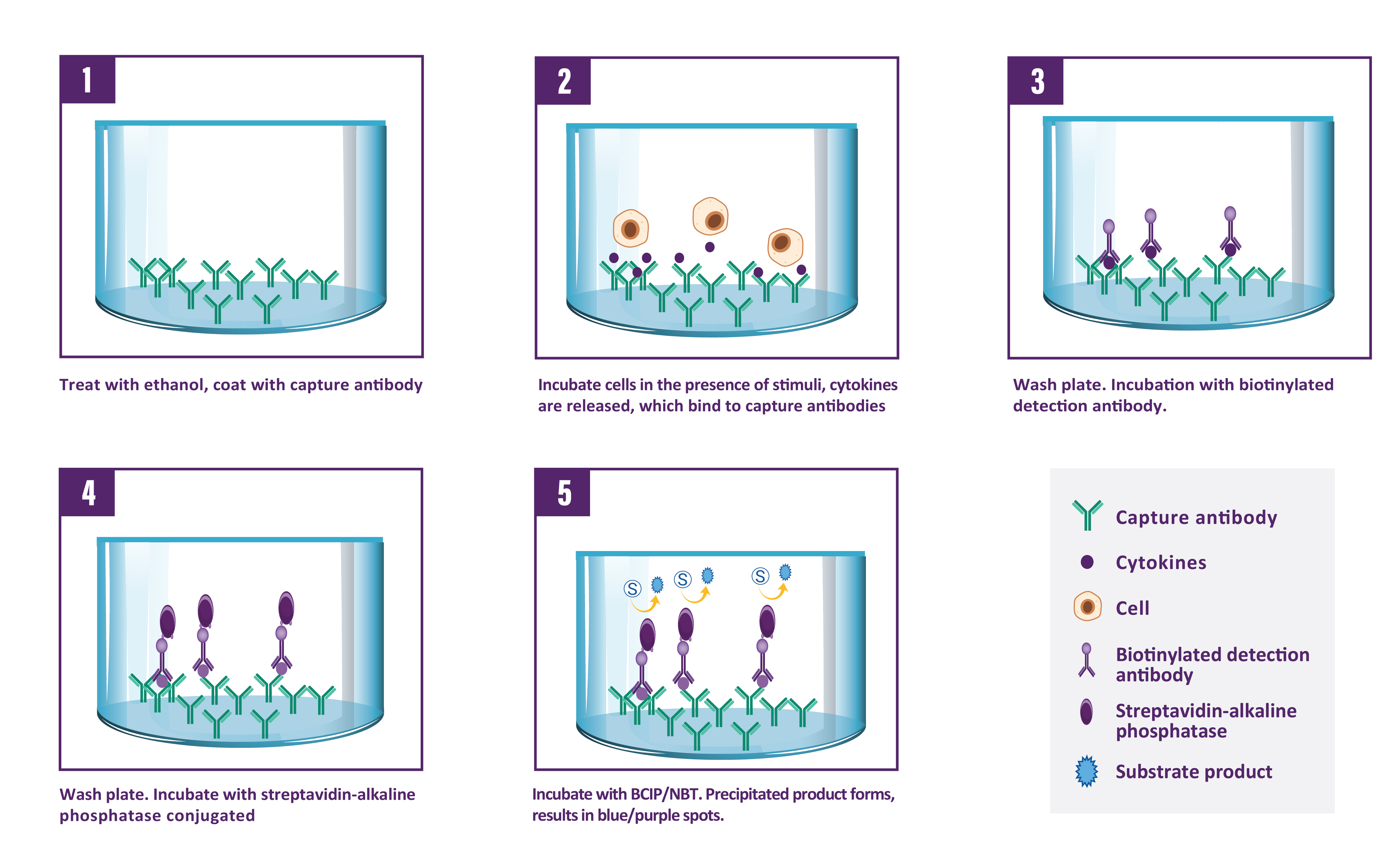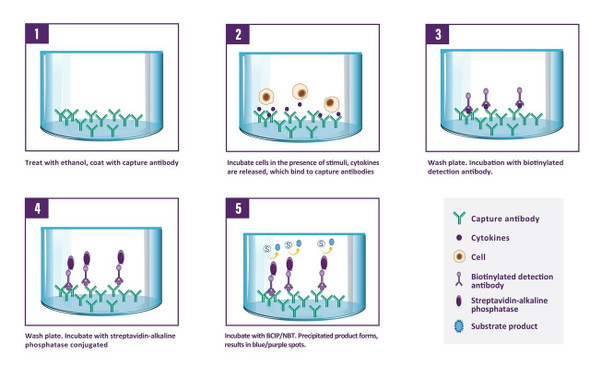Description
Human CD178 ELISpot Pair
Assay Genie ELISpot is a highly specific immunoassay for the analysis of CD178 production and secretion from T-cells at a single cell level in conditions closely comparable to the in-vivo environment with minimal cell manipulation. This technique is designed to determine the frequency of CD178 producing cells under a given stimulation and the comparison of such frequency against a specific treatment or pathological state. Utilising sandwich immuno-enzyme technology, Assay Genie ELISpot assays can detect both secreted CD178 (qualitative analysis) and single cells that produce CD178 (quantitative analysis). Cell secreted CD178 is captured by coated antibodies avoiding diffusion in supernatant, protease degradation or binding on soluble membrane receptors. After cell removal, the captured CD178 is revealed by tracer antibodies and appropriate conjugates.
Human CD178 ELISpot Pair
The Human CD178 (Fas Ligand) ELISPOT Pair is a powerful tool for analyzing the immune response related to Fas Ligand in human samples. This ELISPOT Pair kit offers high sensitivity and specificity, providing accurate and reproducible results for a variety of research applications.Fas Ligand, also known as CD178, is a key molecule involved in the regulation of cell death and immune response. It plays a crucial role in the induction of apoptosis and immune privilege, making it a significant biomarker in diseases such as cancer, autoimmune disorders, and infectious diseases.
By using the Human CD178 ELISPOT Pair, researchers can gain valuable insights into the immune response related to Fas Ligand and its implications in various disease conditions, ultimately aiding in the development of targeted therapies and treatment strategies.
| Product type: | ELISpot Pairs |
| Size: | 10 x 96 Assays |
| Target species: | Human |
| Specificity: | Recognizes natural human CD178 |
| Incubation: | |
| Kit content: | Assay Genie ELISpot matched antibody pairs are extensively validated and include pre-titrated capture antibody and biotinylated detection antibody. Antibodies are supplied in quantities sufficient for 5 x 96 samples. |
| Synonyms: | FAS-Ligand, CD95L |
| Uniprot: | P48023 |
A capture antibody highly specific for CD178 is coated to the wells of a PVDF bottomed 96 well microtitre plate either during kit manufacture or in the laboratory. The plate is then blocked to minimise any non-antibody dependent unspecific binding and washed. Cell suspension and stimulant are added and the plate incubated allowing the specific antibodies to bind any CD178 produced. Cells are then removed by washing prior to the addition of Biotinylated detection antibodies which bind to the previously captured CD178. Enzyme conjugated streptavidin is then added binding to the detection antibodies. Following incubation and washing, substrate is then applied to the wells resulting in coloured spots which can be quantified using appropriate analysis software or manually using a microscope.

| Step | Procedure |
| 1. | Add 100 µl of PBS 1X to every well. |
| 2. | Incubate plate at room temperature (RT) for 10 min. |
| 2. | Incubate plate at room temperature (RT) for 10 min. |
| 3. | Empty the wells by flicking the plate over a sink & gently tapping on absorbent paper. |
| 3. | Empty the wells by flicking the plate over a sink & gently tapping on absorbent paper. |
| 4. | Add 100 µl of sample, positive and negative controls cell suspension to appropriate wells providing the required concentration of cells and stimulant. |
| 5. | Cover the plate and incubate at 37°C in a CO2 incubator for an appropriate length of time (15-20 hours). Note: do not agitate or move the plate during this incubation. |
| 6. | Empty the wells and remove excess solution then add 100 µl of Wash Buffer to every well. |
| 7. | Incubate the plate at 4°C for 10 min. |
| 8. | Empty the wells as previous and wash the plate 3x with 100 µl of Wash Buffer. |
| 9. | Add 100 µl of diluted detection antibody to every well. |
| 10. | Cover the plate and incubate at RT for 1 hour 30 min. |
| 11. | Empty the wells as previous and wash the plate 3x with 100 µl of Wash Buffer. |
| 12. | Add 100 µl of diluted Streptavidin-AP conjugate to every well. |
| 13. | Cover the plate and incubate at RT for 1 hour. |
| 14. | Empty the wells and wash the plate 3x with 100 µl of Wash Buffer. |
| 15. | Peel of the plate bottom and wash both sides of the membrane 3x under running distilled water, once washing is complete remove any excess solution by repeated tapping on absorbent paper. |
| 16. | Add 100 µl of ready-to-use BCIP/NBT buffer to every well. |
| 17. | Incubate the plate for 5-15 min monitoring spot formation visually throughout the incubation period to assess sufficient colour development. |
| 18. | Empty the wells and rinse both sides of the membrane 3x under running distilled water. Completely remove any excess solution by gentle repeated tapping on absorbent paper. |
| 19. | Read Spots: allow the wells to dry and then read results. The frequency of the resulting coloured spots corresponding to the cytokine producing cells can be determined using an appropriate ELISpot reader and analysis software or manually using a microscope. Note: spots may become sharper after overnight incubation at 4°C in the dark. |
| UniProt Protein Function: | FasL: Cytokine that binds to TNFRSF6/FAS, a receptor that transduces the apoptotic signal into cells. May be involved in cytotoxic T-cell mediated apoptosis and in T-cell development. TNFRSF6/FAS-mediated apoptosis may have a role in the induction of peripheral tolerance, in the antigen-stimulated suicide of mature T-cells, or both. Binding to the decoy receptor TNFRSF6B/DcR3 modulates its effects. Homotrimer (Probable). Interacts with ARHGAP9, BAIAP2L1, BTK, CACNB3, CACNB4, CRK, DLG2, DNMBP, DOCK4, EPS8L3, FGR, FYB, FYN, HCK, ITK, ITSN2, KALRN, LYN, MACC1, MIA, MPP4, MYO15A, NCF1, NCK1, NCK2, NCKIPSD, OSTF1, PIK3R1, PSTPIP1, RIMBP3C, SAMSN1, SH3GL3, SH3PXD2B, SH3PXD2A, SH3RF2, SKAP2, SNX33, SNX9, SORBS3, SPTA1, SRC, SRGAP1, SRGAP2, SRGAP3, TEC, TJP3 and YES1. Belongs to the tumor necrosis factor family. 2 isoforms of the human protein are produced by alternative splicing. |
| UniProt Protein Details: | Protein type:Membrane protein, integral; Apoptosis; Cytokine Chromosomal Location of Human Ortholog: 1q23 Cellular Component: extracellular space; lysosomal lumen; perinuclear region of cytoplasm; integral to plasma membrane; extracellular region; plasma membrane; caveola; nucleus; external side of plasma membrane Molecular Function:protein binding; death receptor binding; cytokine activity; tumor necrosis factor receptor binding; receptor binding Biological Process: caspase activation; positive regulation of I-kappaB kinase/NF-kappaB cascade; transcription, DNA-dependent; apoptosis; positive regulation of apoptosis; response to lipopolysaccharide; negative regulation of transcription from RNA polymerase II promoter; signal transduction; cellular chloride ion homeostasis; endosomal lumen acidification; inflammatory cell apoptosis; negative regulation of angiogenesis; induction of apoptosis via death domain receptors; cell-cell signaling; positive regulation of epidermal growth factor receptor signaling pathway; positive regulation of neuron apoptosis; positive regulation of cell proliferation; immune response; retinal cell programmed cell death Disease: Lung Cancer; Autoimmune Lymphoproliferative Syndrome |
| NCBI Summary: | This gene is a member of the tumor necrosis factor superfamily. The primary function of the encoded transmembrane protein is the induction of apoptosis triggered by binding to FAS. The FAS/FASLG signaling pathway is essential for immune system regulation, including activation-induced cell death (AICD) of T cells and cytotoxic T lymphocyte induced cell death. It has also been implicated in the progression of several cancers. Defects in this gene may be related to some cases of systemic lupus erythematosus (SLE). Alternatively spliced transcript variants have been described. [provided by RefSeq, Nov 2014] |
| UniProt Code: | P48023 |
| NCBI GenInfo Identifier: | 1345957 |
| NCBI Gene ID: | 356 |
| NCBI Accession: | P48023.1 |
| UniProt Secondary Accession: | P48023,Q9BZP9, |
| UniProt Related Accession: | P48023 |
| Molecular Weight: | 14,006 Da |
| NCBI Full Name: | Tumor necrosis factor ligand superfamily member 6 |
| NCBI Synonym Full Names: | Fas ligand (TNF superfamily, member 6) |
| NCBI Official Symbol: | FASLGÂ Â |
| NCBI Official Synonym Symbols: | APTL; FASL; CD178; CD95L; ALPS1B; CD95-L; TNFSF6; APT1LG1Â Â |
| NCBI Protein Information: | tumor necrosis factor ligand superfamily member 6; CD95 ligand; fas antigen ligand; apoptosis antigen ligand; apoptosis (APO-1) antigen ligand 1 |
| UniProt Protein Name: | Tumor necrosis factor ligand superfamily member 6 |
| UniProt Synonym Protein Names: | Apoptosis antigen ligand; APTL; CD95 ligand; CD95-L; Fas antigen ligand; Fas ligand; FasL; CD_antigen: CD178Cleaved into the following 4 chains:Tumor necrosis factor ligand superfamily member 6, membrane form; Tumor necrosis factor ligand superfamily member 6, soluble formAlternative name(s):Receptor-binding FasL ectodomain; Soluble Fas ligand; sFasL |
| Protein Family: | S-fimbrial adhesin protein |
| UniProt Gene Name: | FASLGÂ Â |
| UniProt Entry Name: | TNFL6_HUMAN |






